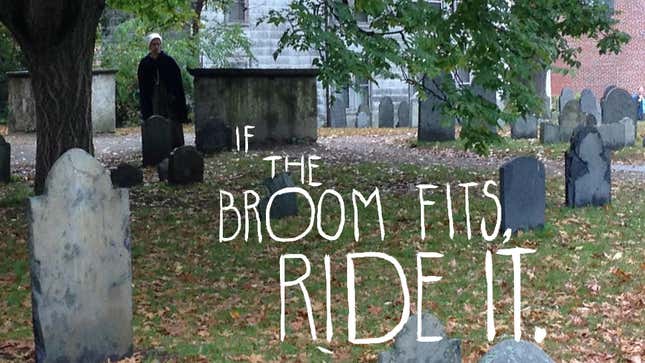
"You're gonna have a great time in Salem," the Boston rental car employee says as she hands me the keys to a weak-engined Chevy. "It's fun around Halloween, but do me a favor."
She drops her voice to a whisper.
"Don't go alone anywhere with someone you don't know."
When I ask her why, she blushes and responds sheepishly. "You know... witches. And the occult."
The rental car employee's fear has its root in the year 1692, when four young girls from Salem Village, Massachusetts, began throwing violent, inexplicable fits. They claimed that they were being tortured—stabbed with pins and painfully gripped—by local men and women who had secretly made pacts with the devil and become witches.
To this day, the true cause behind the girls' behavior remains a mystery. More certain, however, is the destruction that came in their wake. Between February 1692 and May 1693, the Salem Witch Trials claimed the lives of 24 innocent people. Nineteen were hanged, one was pressed to death by stones, and at least four more died in prison while awaiting trial.
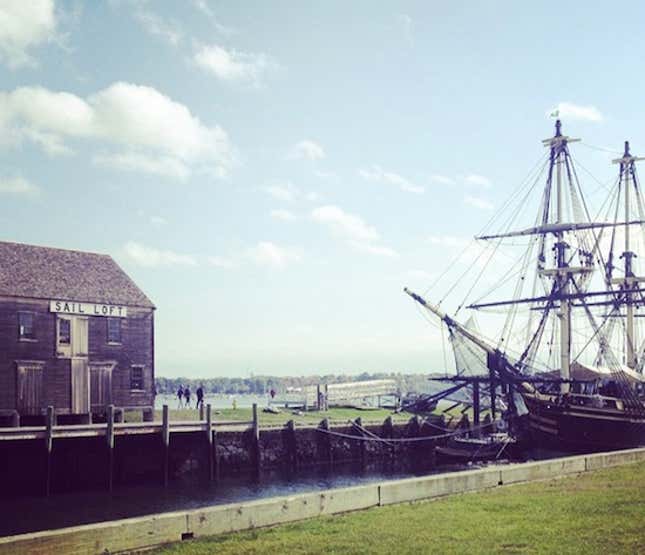
Three hundred and twenty one years later, the area once known as Salem has been divided into several smaller towns. Once a sprawling community, the city of Salem is now condensed into an area of 18.1 square miles, and Salem Village is now known as Danvers. Less than 40 minutes away from Boston, it's in some ways a quintessential New England destination: in the fall, there's beautiful foliage anywhere you look, and local restaurants offer steaming bowls of clam chowder and enough maritime history that, by taking in it all, you might be able to legitimately call yourself Master and Commander.
The idyllic Salem of today couldn't be more at odds with the panic-stricken, puritanical and bloody image the town holds in history. And yet, despite all that progress and modernity, the area remains intrinsically (and sometimes clownishly) linked to the witch trials of 1692. Salem police cars are decorated with motifs of witches on broomsticks; the Salem High School sports teams are called The Witches. Essex Street, the busiest in town, overflows with shops that offer potions, candles, and fortune-telling services.
According to the Official Salem guide, the city gets 30 percent of its annual tourism during the month of October. While the town's rather serious Peabody Essex Museum will try to tell you that many visitors have come to see the hometown of author Nathaniel Hawthorne or what was once America's largest sea port, the truth is that most people are there to look at witch kitsch and to visit the site of the most frightening and mythologized mass murders in American history.
The latter was, at least, my reason for visiting.
Traveling to Salem fulfills a decades-long, rather bleak dream of mine. As a child, I read endless books about the Salem Witch Trials, chose it as the subject for various school reports, and convinced my mom to let me watch Arthur Miller's The Crucible long before I knew what an allegory was. The macabre curiosity has lingered into my adult life, even as its entertainment value has slightly diminished. Going to Salem to immerse myself in all things witch-y makes me a bit of tragedy tourist, much like the people who stay at the Lizzie Borden B&B or visit the home of Madame LaLaurie. I remind myself that it's important that one of the only upsides of tragedy tourism is its illumination of the historical context that brought you there.
It's important in theory, anyway. Immediately upon entering Salem, the historical weight of the witch trials is somehow simultaneously lifted from my consciousness and shoved in my face. A statue of Samantha from Bewitched has a prominent place in the center of town; gift stores boast names like "Hex" and "Omen"; banners advertise Salem's scariest haunted house (which is located in a strip mall); reenactors walk the streets, occasionally staging arrests. This city is 1692: The Theme Park.
The air of nonchalant inauthenticity is inescapable. When I check into the hotel, I overhear the receptionist tell a caller, "We leave it up to our guests to decide whether or not the rooms are haunted. We have had ghost-hunters come and they didn't find anything." The disappointed person on the other end of the line doesn't follow through with booking a room, which is probably for the best, as the hotel was only built in 1925—and if there is a ghost in residence, Giles Corey he most certainly is not.
After ditching my suitcase in my (possibly haunted) room, I head to Salem's Old Town Hall to watch Cry Innocent: The People Vs. Bridget Bishop, an interactive staged trial that asks its audience to pretend like it's 1692 and act as the jury presiding over the preliminary hearing of Bridget Bishop (a real victim of the Salem Witch Trials) who is being charged with witchcraft. A small troupe of actors presents testimony. The audience is allowed to cross-examine witnesses, and then we vote Goodwife Bishop guilty or innocent.
"Try to hear this evidence as though you are a person from the 17th century," the actor playing the prosecutor reminds us time and time again. I think about something Ask a Mortician's Caitlin Doughty wrote in her book, Smoke Gets In Your Eyes:
It is easy for someone in the twenty-first century to be dismissive and declare, "Dang, those medieval folk are so crazy with their flying demonic minions and sex pacts." Yet witchcraft was as real to medieval men or women as the Earth being round or smoking causing cancer is real to us. It didn't matter whether they lived in a city or a small village, whether they were a lowly peasant farmer or the pope himself. They knew that there were witches and the witches were killing babies and crops and having lewd sex with the devil.
The same can be said for the Americans and, really, we don't have to go that far back to find people who believed whole-heartedly in the harm caused by witchcraft. In fact, we don't have to go back at all: Just look at the Hertz employee who rented me my car.
Since I go to see Cry Innocent on a Tuesday afternoon, the majority of my fellow audience members happen to be high school students. And since they're high school students, they decide, en masse, to vote Bridget Bishop guilty as a joke. (I vote her innocent because of FEMINISM, but my act of sisterhood is entirely in vain.)
"By voting Bridget Bishop guilty, you have upheld the ruling that was made over 300 years ago," the actress playing Bridget Bishop, having dropped character, informs us. "Twenty innocent people were executed between 1692 and 1693 because of verdicts like this one."
Behind me, a middle-aged woman dressed in an "If the broom fits, ride it" t-shirt gasps and turns to her friends in surprise."Wait," she says without a trace of sarcasm. "You mean she was innocent the whole time?"
While I promised the car rental employee that I would be wary of the occult, the truth is that I'll spend a large portion of my time in Salem with the members of a modern-day coven who've come to town because of its "spiritual pull" and—more importantly—the large number of tourists who are willing to pay boatloads of money to have their cards and palms read by that coven.
I arrive at Hex to meet Leanne Marrama: a medium, psychic, self-identified witch and former What Not to Wear participant who has agreed to give me a reading. I'm skeptical, but pleasantly surprised when I meet her. She's intense in a way that implies passion and conviction over craziness and, even with her long black hair and ankle-length black skirt, she looks more like a woman you'd encounter as she drops her kids off at school than at a midnight spell circle in a cemetery.
"You have crazy animal spirit energy around you," she tells me as she gives me a tour of the shop. "Dogs, cats, horses, everything." She then leads me and my spiritual menagerie to an altar where people have left tokens and notes for their dead loved ones.
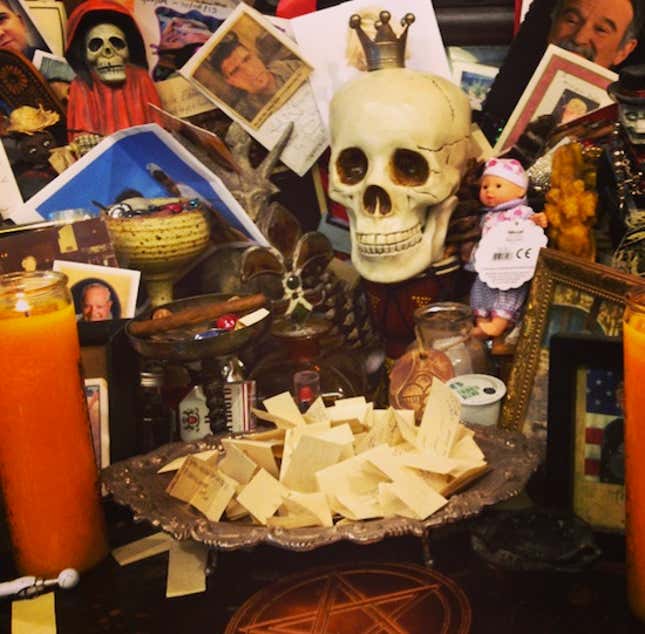
"This is my favorite part of the store," she says, going onto explain how important it is that people are willing to trust her and her fellow witches with relaying messages to their beloved departed. On the altar are photos of relatives, friends, pets, victims of the Boston marathon bombing and—a more recent addition—Robin Williams. Cigarettes, chocolate and coins have been left as a tribute. The altar is both a sad and heartwarming sight.
She gives me a minute to study the altar, then leads me to a private, curtained-off area for a psychic reading. Truthfully, I find visiting psychics a mildly nerve-wracking experience—not because I'm worried about the ceremonial sacrifice that the rental car lady warned me about, but because I have, on no less than three occasions, been told by psychics that my heart is too cold to know love and — whether you put stock in tarot cards or not — that's never a fun thing to hear.
Leanne doesn't tell me that my heart is hard or freezing, but she does offer some fairly amazing (and specific) insights into my family, love life, and longterm career goals—most of which she could not have had prior knowledge to. She even manages to guess the astrological sign of both me and my mother, which, sure, doesn't have much bearing on our futures, but it's a hell of a party trick all the same.
"You should go to the Crow Haven Corner to see Lorelei," Leanne tells me as she wraps up my reading. "She's Salem's famous love clairvoyant. Say that I sent you."
Lorelei and Leanne have been friends and fellow witches for years, having bonded over their love of animals (together, they run a non-profit that's dedicated to preventing animal abuse) and through their business partner, warlock and accidental crushed velvet top hat model Christian Day. (Christian will be mentioned several times throughout the day that I spend with the coven, but I will never get to meet him.)
I arrive at Crow Haven Corner and speak to the shopkeeper, who invites me back to Lorelei's sitting room, which is heavy with the scent of incense. A large altar occupies most of its space: all the leftover room is taken up by the small-boned Lorelei and her many pet dogs.
"If someone doesn't like dogs, I won't read 'em," she says in what might be the thickest Boston accent I've ever heard. One of the dogs growls at me aggressively, but I assure her that I like dogs fine and begin to tell her why I'm here.
"I work for a website called Jezebel," I explain. "And I'm writing a story that's partially focused on the modern witches of Salem."
"Oh, yeah," Lorelei responds. "You guys wrote about it when Katy Perry came in for a love spell."
I have no memory of us writing about Katy Perry visiting the Crow Haven Corner. Feeling flustered, I nod my head.
"You have to let me do a love ritual on you," she continues. "You know, like the one that Katy got."
What's good enough for Katy is certainly good enough for me.
A couple hours later, we reunite at Crows Haven Corner and, once again, I am brought back into the sitting room. She begins by reading my palm (apparently, my hands say both that I like being in control and that I don't fuck regularly enough, so there's that) and then my cards.
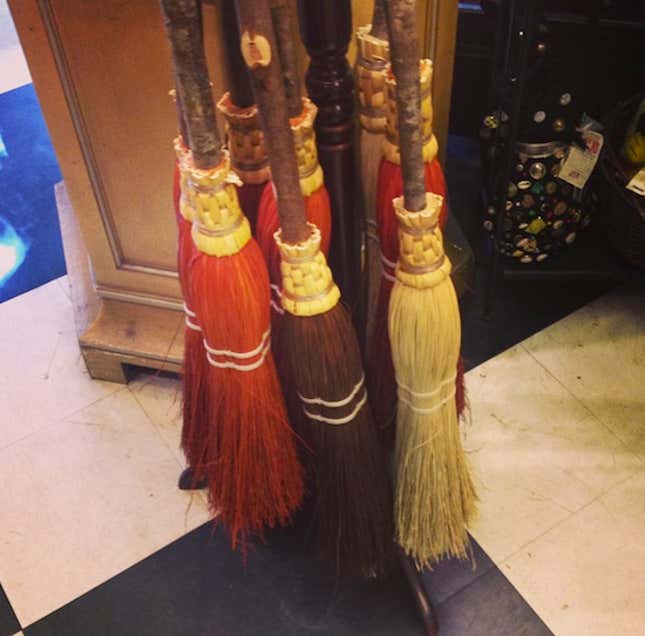
Her reading doesn't feel as accurate or specific as the one I received from Leanne earlier that day; plenty of her insights feel like easy guesses. But, as promised, Lorelei excels in psychic matters of the heart. She somehow manages to pinpoint each romantic disaster and humiliation I've experienced in the past few years (it's rough out there when you allegedly have a heart of ice) and says, "I'm going to help you with all of this. Just like I'm helping Katy Perry."
With that, the love ritual begins. We stand at opposite ends of the altar as Lorelei waves around a small, decorated dagger and calls upon the elements. In a small bowl, she mixes herbs and dried flowers. "For passion," she says, mixing in petals. "For serenity"—she tosses in lavender—"for romance"—and so on.
"Hold out your left hand," she orders, reaching towards me with the dagger. I put aside any reservations that she's about to stab me and do as I'm told. Lorelei then takes her knife and runs the flat edge of the blade along my palm. Handing me a lovely-smelling sachet, she instructs me to carry it on my left side. With her assistance, she says, I should meet a "soulmate" in 8 to 10 months.
"Merry meet, merry part, and merry meet again," she says, grinning and gripping my hands.
I move to go, but Lorelei stops me. She has a few more Katy Perry thoughts to share.
"I wanted to do a travel protection spell for her on Halloween because I know she's tryna go to Egypt, but my business partner Christian, he says, 'No, Lorelei. Halloween is for the dead.'" She pauses to stroke the ear of one of her sleeping dogs. "So I've decided to do Joan Rivers instead."
While a lot of what I do with the modern day witches of Salem feels mildly-to-extremely ridiculous, I'm still having an enormous amount of fun. Even as I watch a 27-year-old witch dump half of her Dunkin' Donuts iced coffee over a 17th century grave in the town's historic cemetery as means of tribute, I'm still having fun. By the time I meet Leanne and her friend Tim (a fellow witch) for dinner in a mall food court, I'm practically bouncing from the day and they're nice enough to let me bother them with questions about their faith and practice as they eat their mozzarella sticks.
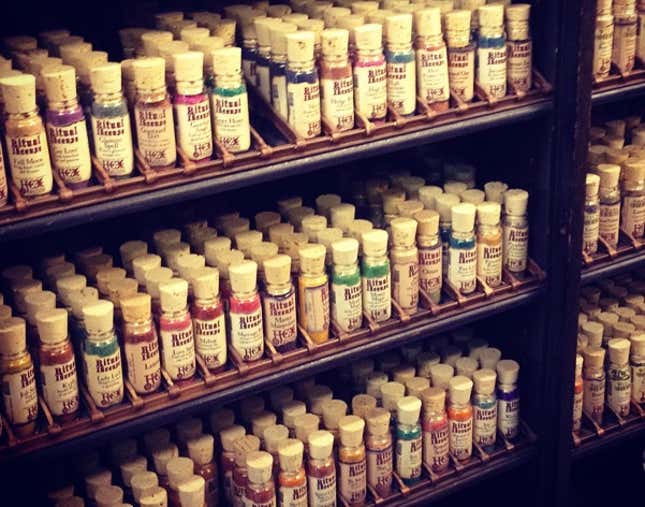
I ask if they consider themselves Wiccans and they both say no. They tell me that you can be any religion and still identify as a witch. When I inquire after when they both decided to identify as witches, they have very different answers. Tim says that he's known since he was a boy and was drawn to spells and nature. "I ruined my mother's dining room table by painting witch symbols on it with nail polish." He also talks about the time when he was 12 and his neighbors caught him dancing naked in the woods. His parents were mortified.
Leanne's story starts a little later in life. Her mother worked in finance, but would read cards for friends as a hobby. Leanne realized that she, too, had some psychic ability when she was a teenager, but suppressed it. At a young age, she married an unsupportive and unkind husband. It was only after she divorced him that she could start openly identifying as a witch.
"That must have been freeing," I say.
"It was, it was," she responds. "It was like coming out of the closet."
I ask what brought them to Salem. "It seems a little weird, you know," I say. "Since this is a town that's famous for prosecuting people on the mere suspicion of witchcraft."
Leanne and Tim explain that coming here is both healing to the area's energy and a form of reclamation—almost in a "You thought they were witches? We'll show you witches" kind of way.
"OK," I say. "Now what about the clothes. Do you have to wear the clothes of a goth teen or is that a choice?"
They both laugh. "That's a very What Not to Wear question," Leanne tells me.
Once Tim and Leanne have finished eating, I follow them to Omen, where Leanne is hosting a séance for tourists. I, along with 20 others, sit in a row of chairs and watch as she explains how to contact the dead through table tipping and staring at a mirror in the dark.
Then she has us try it for ourselves. Table tipping is basically the ghost-obsessed equivalent of Light as a Feather/Stiff as a Board, but it's still spooky. (That could just be because Omen shares a wall with a haunted house, and the entire séance is soundtracked with recorded screams of someone getting murdered.)
For the second half of the séance, Leanne attempts to communicate with the dead loved ones of the room's living occupants, and I am slightly overcome: watching my fellow attendees try to make contact with the people (and, in some cases, animals) that they've lost is a devastating experience. Whether it's real or not doesn't really matter: I watch a woman panic because she left her husband's old reading glasses at home and doesn't think that Leanne will be able to reach him without them.
"It's OK," Leanne says, comfortingly. "He hated wearing glasses, anyway."
People openly weep as they receive what they believe to be messages from spouses, grandparents and friends. I cry, too. Not because my dead show up to say anything, but because it's overwhelming to witness the sorrow and loneliness that's left behind when a person dies. The room's energy is raw and fragile, something that Leanne, to her credit, handles with sensitivity and care.
"Séances are my least favorite part of the job," she tells me privately. "There's so much responsibility."
The evening ends and the other participants all seem satisfied with the spirit contact made. Feeling unsettled after sharing such an emotionally intimate moment with a group of strangers, I hug Leanne goodbye, and go off to find something to eat. Unfortunately, because it's 9 pm and Salem is tiny, every restaurant is closed.
For a town so hopping with spirits, Salem sure is dead at night.
I leave Salem feeling about as confused as I was when I got there. My initial judgment, though, is intact: excepting a few monuments, the city feels more like a recreational boardwalk than the landmark of an atrocity. Even the town's more historic offerings manage to paint over facts in order to be more palatable or entertaining. ("Did you know that my employers do not allow me to refer to Tituba as a slave? I have to call her a servant and it's bullshit," one young tour guide tells me after learning that I write for Jezebel.)
Speaking with Kristina Wacome Stevick, the artistic director of History Alive! (the production company behind Cry Innocent), helps settle my mind.
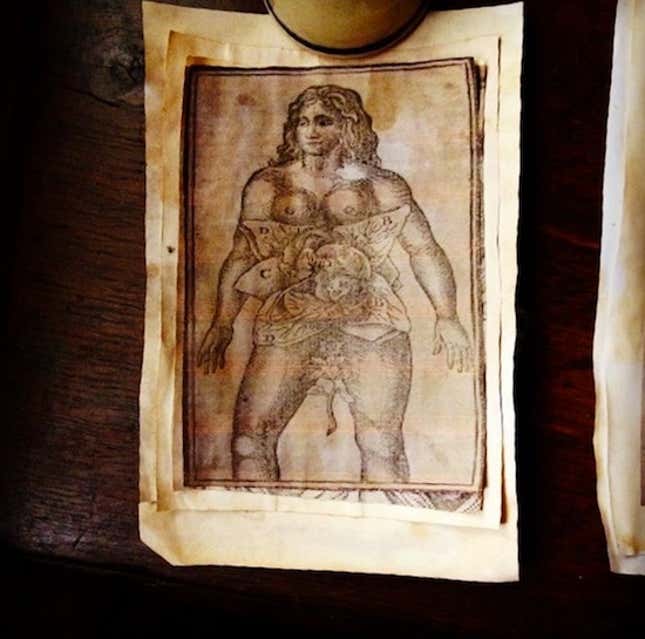
"It is ironic that out of one side of our mouths we can say that [the 24 people who died during the Salem Witch Trials] were innocent victims and at the same time say that they're the spiritual ancestors to [these modern day witches]," she tells me. "I think the 17th century accused witch would be like, 'Who are you and why are you claiming this affinity?'"
"At the same time," she continues, "I've made peace with it, I guess. I don't know that people would be coming to Salem as much as they do if it weren't for that mercenary side of things. When they're here, hopefully they can learn some history."
Besides, she adds, no tourist location in Salem (apart from Peabody Essex, maybe) is guiltless when it comes to prioritizing entertainment over history. That's how these businesses stay alive, it's how the town makes money.
Even if the town could forgo the tourist income, it's questionable whether or not we could ever truly remember Salem with the reverence that some think it deserves. In America, we're good at showing sorrow and solemnity when it's white men that have died (Gettysburg, the Alamo, etc.). But when the dead are women, or people of color, the ground seems to become fair game for anything: weddings at plantations, palm readers and "If the broom fits, ride it" T-shirts here.
But witches like Leanne and Lorelei aren't bringing any harm or bad intentions to the area, and some might even argue that they—witches, occult, and all—are bringing in good will. As I drive the rental car back to Boston, I think of the herb sachet from Lorelei that now sits in my bag, firmly pressed to my left hip. Best case scenario, her spell worked and I meet the love of my life in 8-10 months. Worst case scenario, my purse smells fantastic.
Photos by Madeleine Davies, type by Jim Cooke.